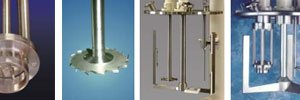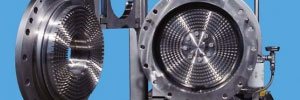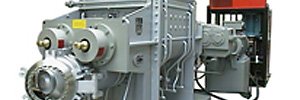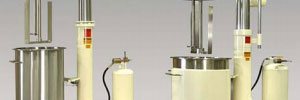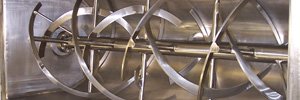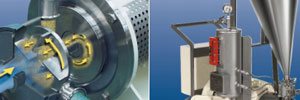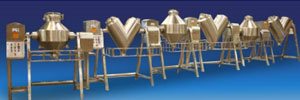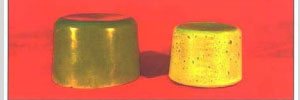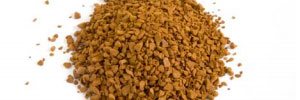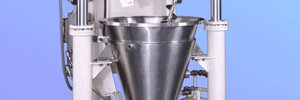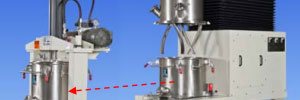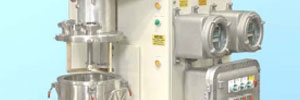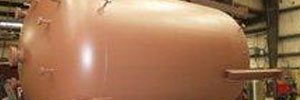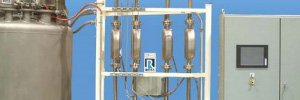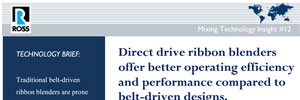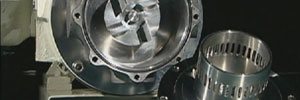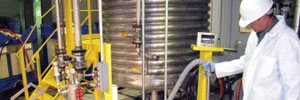Plastics and Composites
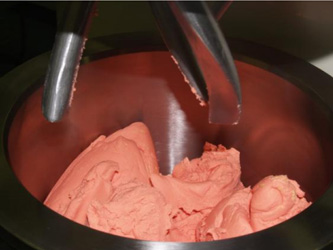
New technologies are powering the drive to develop renewable energy. Spacecraft that are commercially viable, airliners that leave a smaller carbon footprint, and cars that can cruise all day long without burning a drop of gasoline.
From syntactic foams and aerospace composites to specialty elastomers and thermoplastics, ROSS Mixers are well-proven in the manufacture of low to high viscosity applications within the plastics and composites industry.
- Polyamide - Polyamides (Nylon) is a family of engineering plastics with a very wide range of applications, from footwear to lenses to aircraft components. One processing example encountered in our test laboratory is concentration of polyamide polymer through a combination of heat and vacuum which lowers NMP solvent content from 60% to around 0.5%.
- Plastisols - Polyvinyl chloride (PVC) plastisols are generally composed of powdered PVC resin and fillers dispersed in a liquid plasticizer; they may also contain small amounts other additives such as stabilizer, pigments or colorants, and adhesion promoting compounds. The components of a plastisol are combined and mixed to form a coating which may be applied to a substrate or formed into a shape. Plastisol formulations are mixed using planetary mixers such as the ROSS Double Planetary Mixer and ROSS PowerMix or multi-agitator mixers such as the ROSS VersaMix.
- Organosols - similar in composition to plastisols, but containing volatile solvents or thinners. With the application of heat, plastisols and organosols fuse into a functional tough coating highly resistant to abrasion, corrosion and electrical currents.
- Reaction Injection Molding Formulations - RIM is a process where streams of polyol and isocyanate are brought together just prior to the inlet of an injection mold. The polyol and isocyanate react immediately to form a rigid polyurethane or polyurea part. One drawback to conventional RIM parts is their relative flammability. This lead to development of RIM modifiers to make these materials less likely to burn. One such modifier is a urea-based material which increases the flame retardancy of RIM formulations. The only limitation to the use of the urea is its difficulty in being dissolved and incorporated into the polyol. The urea is produced in pellet form and it can also be ground into a fine powder. Through extensive testing of different urea forms, one chemical company concluded that the best method for incorporating the urea into the viscous polyol is by using a ROSS Inline High Shear Mixer with a recirculation vessel. A mixing system consisting of a ROSS HSM-405 and a 60-gallon recirculation vessel was constructed for this company that specializes in RIM processing equipment. The Inline Recirculation Mixing System is now part of a larger RIM processing system.
ROSS Cone Screw Vertical Blenders is also used for RIM applications. Its thorough but gentle mixing action is the reason that these units are so successful at mixing the RIM formulations without damaging the delicate mica, wollastonite and glass particles. These fillers improve the mechanical properties of RIM panels and also limit shrinkage and thermal expansion. The cone shape of the vessel allows for convenient charging of components through the cover of the blender and easy discharge through the bottom of the cone. Cone Screw Vertical Blenders are often mounted on load cells for RIM blending applications. - Polymer Additives - A ROSS customer manufactures preblended polymer additives that are widely used in the plastics industry in PVCs, polyolefins, and rubber compounds. These additives prevent plastic degradation caused by high heat or UV radiation exposure, protecting such end products as plastics bags, floor coverings, vinyl siding, automobile dashboards, and disposable diapers. To make the additives, the company blends several powder ingredients together with a very tight composition specification. After blending in a ROSS Ribbon Blender, the additives, also known as processing aids or polymer stabilizers, are further processed into a pellet or other compacted product.
- Filled Rubber - a leading supplier of medical products for the global aesthetic medicine market came to ROSS to identify a suitable mixing system which they can use to incorporate barium sulfate powder into a gum rubber. They were experiencing frequent maintenance issues with their existing planetary mixer as the stress of mixing the gum rubber puts considerable strain on the drive system and ultimately leads to shaft seal failure. Testing proved that a Heavy-Duty Double Planetary Mixer with High Viscosity "HV" Blades is the ideal mixer for this tough application.
- Syntactic Foams - ROSS Double Planetary Mixers are exceptionally suited for filling polymers or ceramics with hollow spheres (microballoons, glass microspheres, etc.). The ROSS DPM's mixing action quickly and completely disperses hollow spheres into a viscous liquid, without fracturing the fragile balloons. These composite materials are useful for their low density, high strength, and low thermal expansion properties.
- Thermoplastic Modified Epoxies - a ROSS customer utilizes the VersaMix to manufacture a polyethersulfone (PES) modified epoxy resin used in advance composite systems. Due to the VersaMix's multiple agitators and jacketed vessel, heat is distributed very evenly throughout the starting resin blend which decreases in viscosity with temperature. Under vacuum, PES powders are dispersed efficiently, and therefore dissolve completely.
- Urethane with Polystyrene Beads - the end product is a rigid, strong, low density foam-like material used in construction and other composite material applications.
- Recommended Mixing Equipment for Gel Coats
Gel coats (or gelcoats) are modified resins applied to molds in the manufacture of fiber-reinforced plastics. - Recommended Mixing Equipment for Bulk Molding Compounds
Proper mixing is critical in achieving the desired physical properties in the final molded product. This bulletin discusses the benefits of preparing Bulk Molding Compounds in a well-designed Double Planetary Mixer. - Recommended Mixing Equipment for Graphite Dispersions
Graphite, a highly conductive crystalline form of carbon, is used in a wide range of products, from batteries, heat sinks and solar cells to coatings, lubricants and composites. - Recommended Blending & Drying Equipment for Nylon Pellets
Nylon pellets are commonly blended with other plastics, coated with a powdered lubricant or mixed with concentrated pigments and other additives. - Recommended Mixing Equipment for Polyester based composites
Polyester is one of the most commonly utilized resins in the manufacture of inexpensive yet high-performance composites and coatings. Automotive and marine fiberglass parts, building panels, junction boxes, sporting goods, body fillers, fairing putties and other polyester-based products are essentially resins intimately mixed with reinforcing agents, pigments, fillers and/or additives to achieve a specific set of physical and chemical characteristics. - Recommended Mixing Equipment for Plastic Resins
Drying is an important operation in plastics production because excessive moisture in the starting resin material can result in visual defects, lower strength and reduced performance of the finished part. - How to increase shear without sacrificing throughput
Ultra-high shear mixers are ideal for homogenization, emulsification and solubilization requirements where particle or droplet size is critical. These devices are as simple to operate as regular rotor/stator mixers but are capable of intense hear levels as well as high pumping rates. - Improve your extrusion process with a static mixer.
Interfacial Surface Generator (ISG) Static Mixers are particularly ideal for use in injection molding and extrusion applications. Benefits include uniform temperature and viscosity, accurate composition and highly repeatable quality of the finished product. - Mixing Thermoplastics
The mixing of thermoplastic materials requires precise temperature control, sufficient shear and efficient agitation. This bulletin outlines some useful considerations for mixer selection. - Proper mixing of hollow
microspheres
Hollow microspheres are added to various materials to reduce weight and improve strength but in their dry form, these fillers present a mixing challenge due to their tendency to break under high shear conditions. Selecting the suitable mixer for a particular application is based on the viscosity of the liquid vehicle and the crush strength of the microspheres. Batch and continuous mixing solutions are discussed in this bulletin. - Buying reconditioned mixing
equipment
When properly restored to perfect working condition, ideally by the OEM, a reconditioned mixer or blender is comparable, if not equal, in efficiency to new equipment. The savings in cost and faster shipment help you get to the profitable stage sooner without sacrificing reliability. - Asking the right questions
about vertical blenders
When in the market for a new vertical blender, knowing what questions to ask will help you select the best equipment features that suit your specific application and properly compare offerings from different suppliers.. - Polymer grinding and
disintegration
High shear rotor/stator mixers are ideal for many polymer dispersion and dissolution processes. Different configurations are available depending on the application requirements. These include batch and inline designs, multi-agitator systems for high viscosity formulations, and even special ultra-high shear rotor/stator geometries that deliver faster polymer disintegration and more intense mixing. - High-torque, low impact
mixing of viscous composites
Double planetary mixers provide thorough, low impact agitation ideal for intimate mixing of delicate fillers into high viscosity materials. - Mixing abrasive pastes and
slurries
Dispersion of abrasive solids into liquid can be accomplished in single-shaft, multi-shaft or planetary mixers, depending on product rheology and degree of abrasion. This bulletin discusses some strategies for combating abrasive wear in these types of mixers. - Inline mixing of gases and liquids
Efficient mixing of gases and liquids is a critical step in many chemical and biological process technologies. Static mixers and inline rotor/stator mixers are typically used in gas-liquid applications where high intensity mixing, short contact time and/or continuous processing are required. - Mixing dilatant materials
Dilatant materials pose a unique mixing challenge due to their very nature: the greater the shear forces applied to the material, the more resistance is encountered. Heavy-duty, high-torque double planetary mixers operated under comparatively low speeds are ideal for processing shear-thickening mixtures. - Effectively disperse fibers into your viscous mix.
Many fiber-filled composites are high viscosity formulations that require efficient dispersion in a planetary mixer configuration where a number of blade designs and combinations are available. Fiber characteristics and composite rheology are the main factors evaluated in the mixer selection process. - Benefits and techniques of
vacuum mixing.
Mixing under vacuum offers numerous benefits including elimination of unsightly voids in the finished product, improvement of dispersion quality, degassing, enhanced drying at lower temperatures and sub-surface addition of raw materials. Fine-tuning vacuum mixing techniques leads to the optimization of these benefits. - Ribbon blenders are ideal for coating and mixing processes.
Solid-solid mixing sometimes involves powders that need to be uniformly coated with smaller particles of a different component. The ingredient that is coated onto the bulk material is typically a very small percentage of the batch, thus requiring thorough and uniform blending. Ribbon blenders are proven to be highly effective for these coating and mixing operations. - High speed mixing: saw-tooth dispersers vs. rotor/stator mixers
The saw-tooth disperser and rotor/stator mixer are two of the most widely used high speed mixers yet many are unaware of the differences in their utility and operating capacities. Knowing the unique attributes of these devices is important in mixer selection and process optimization. - Consider the advantages and disadvantages of scrapers.
Consider the advantages and disadvantages of scrapers.
The use of scrapers in batch mixing operations helps improve product homogeneity and heat transfer efficiency. However, there are cases wherein scrapers are not recommended such as in the processing of abrasive applications or highly viscous, sticky materials. - Vertical blender/dryers deliver high drying rates with negligible risk of product attrition.
Vertical blender/dryers designed for vacuum operation offer a better alternative to non-agitated dryers such as ovens and tray dryers, delivering significantly higher drying rates per unit heating area. Vertical blender/dryers can also handle a variety of feed forms including slurries and pastes which other types of agitated dryers cannot accommodate. Finally, the gentle mixing action supplied by a vertical blender/dryer minimizes product attrition which is a concern in some applications. - Double planetary mixers are ideal for low shear processing of viscous materials.
Viscous products possessing shear-sensitive behavior, fragile components or abrasive properties require gentle but thorough mixing. In most cases, a double planetary mixer is the best choice for processing such applications.

